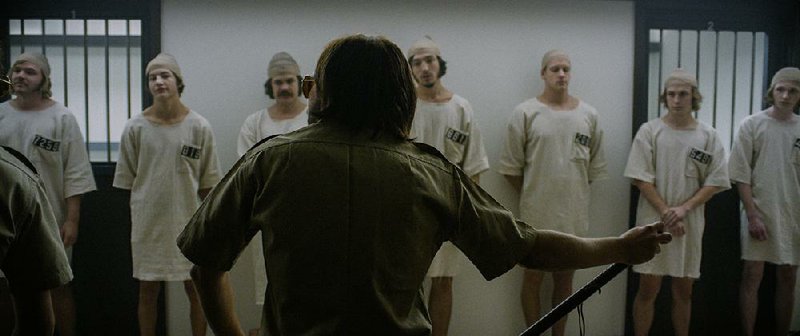Philip Zimbardo's infamous 1971 experiment on prison life and power dynamics is dramatized straightforwardly, and surprisingly effectively, in Kyle Patrick Alvarez's crisply directed and at times difficult-to-watch The Stanford Prison Experience.
Unlike the 2001 German film Das Experiment (which I've seen) and its American remake (which I haven't), Alvarez doesn't feel the need to soup up the facts of the case, which should be familiar to anyone who sat through a Psychology 101 survey.
The Stanford Prison Experiment
87 Cast: Billy Crudup, Ezra Miller, Michael Angarano, Tye Sheridan, Keir Gilchrist, Johnny Simmons, Ki Hong Lee, Thomas Mann, Nelsan Ellis, Olivia Thirlby
Director: Kyle Patrick Alvarez
Rating: R, for language including abusive behavior and some sexual references
Running time: 122 minutes
During summer break, Zimbardo (Billy Crudup, channeling a little Charlie Manson-like charisma) and his team of graduate research assistants clear out some faculty offices at Stanford University to serve as prison cells and place an ad offering $15 a day for volunteers to participate in a study on human behavior. The film opens with a montage of the interview process, during which prospects are asked rudimentary questions about drug use, their reasons for wanting to participate in the study (for the money, mostly) and whether they would like to be a prisoner or a guard in the study. Perhaps not surprisingly, given the era, none of them want to be the authority figures. "It sounds like less work to be a prisoner," one says. "Nobody likes guards," adds another.
Nevertheless, half of the 24 students are chosen at random for the job. But they're told they were selected because of the "exemplary qualities" they displayed during the interview process. The guards are outfitted with khaki uniforms, dark glasses and instructed to "keep order" but were warned that "under no circumstances, whatever, are you to hit or physically assault the prisoners in any way."
On the first day, those chosen to be prisoners are picked up by police officers, blindfolded and carried off to the "prison," where they are made to strip, "deloused" and outfitted in dress-like gowns and hair nets. They're assigned numbers they're expected to use in lieu of names. They are to address the guards only as "Mr. Correctional Officer."
It takes remarkably little time for things to start to go off the rails -- there are a few smiles as the men fall into their roles, but one of the guards, Chris (Michael Angarano), begins inflicting petty humiliations on his charges almost immediately. When he's told his dark glasses make him look like "that guy from Cool Hand Luke," he begins mimicking the Southern accent of the sadistic character played by Strother Martin in the film.
Before the end of the first day, the prisoners are beginning to feel their deprivations are chillingly real.
Zimbardo and his fellow researchers are drawn into the weirdness as well -- we realize that they are so excited by their findings that they're tacitly condoning the bullying behavior of the guards. A former San Quentin inmate (Nelsan Ellis), brought in to observe and advise, assures them that what they're witnessing isn't an aberration. Though in the end Zimbardo reluctantly pulled the experiment, originally scheduled to last two weeks, after six days, you'll wonder how they could have held out so long.
There's a strange dynamic at work in this film; while the large cast is generally excellent, we begin to see the study participants as less than individuals. Part of that is because of the period-appropriate hair and sideburns, but the larger part may be that we -- like Zimbardo and his team -- begin to see them as less than fully human. Ezra Miller stands out as the most rebellious prisoner, but it's honestly difficult to remember who did what to whom.
That's sort of the point, both of the film and Zimbardo's research -- there is something inherently toxic in certain institutional situations. The arbitrary assigning of class or status ends up having real-world consequences and contributes to real-world atrocity. What happened at Stanford in the summer of 1971 goes a long way toward explaining the behavior of Americans at Abu Ghraib (which Zimbardo also studied), as well as the Rwandan genocide and the Good Germans who enabled Hitler.
This is one cold look in the mirror for us human animals. We want to look away. We can't. We shouldn't.
MovieStyle on 08/21/2015
